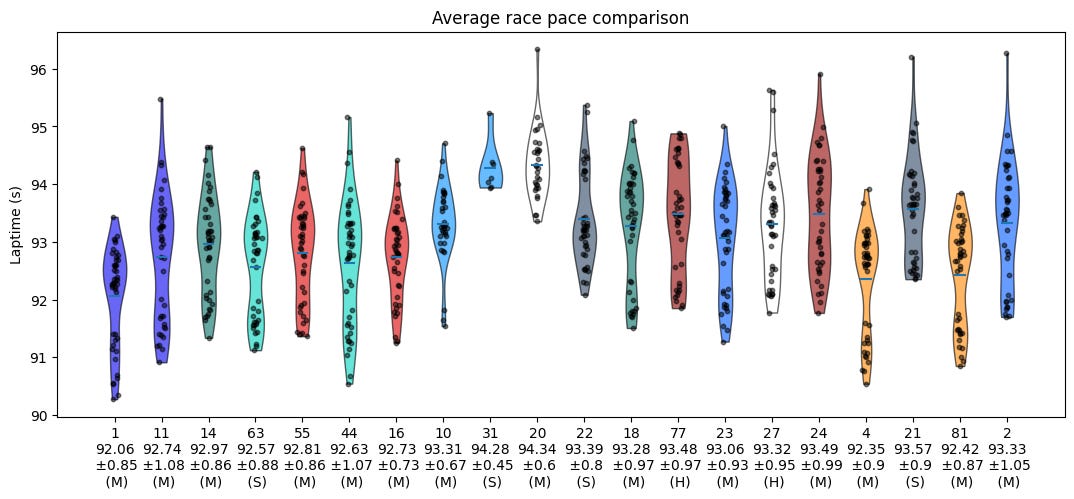

The British Grand Prix brought back the usual format for the weekend, and it delivered another exciting round of racing. McLaren continued to impress, showing great pace throughout. It was also the final race weekend for Nyck De Vries, who was released from his seat and would be replaced by Daniel Ricciardo moving forward. Sergio Perez faced disappointment once again, getting knocked out in Q1 for the fifth weekend in a row. The weekend also featured some rain, adding an extra element of unpredictability.
The race showcased several thrilling battles throughout the field, although they might not have reached the intensity of last year's thrilling final laps. Nonetheless, it was an enjoyable weekend overall, with exciting on-track action. For the purpose of this discussion, we'll focus on the qualifying session and the race itself, omitting the practice sessions.
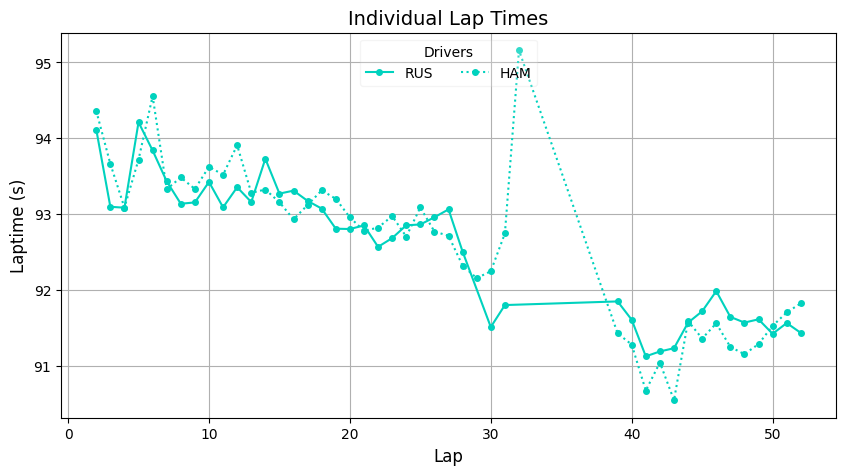
Over the weekend, Mercedes showed a slight improvement compared to the previous week, securing sixth and seventh positions in qualifying. This was a step up from their struggle to advance beyond Q1 in the previous race. In Q1, George and Lewis recorded nearly identical lap times, with George setting a time of 1:29.412 and Lewis just slightly behind at 1:29.415. However, they were likely disappointed to see two McLaren cars powered by Mercedes engines ahead of them, as well as Albon in the Mercedes-powered Williams right behind them. Overall, the qualifying session revealed that Mercedes' recent upgrade package did not result in significant progress.
An interesting observation is the close performance comparison between Mercedes and Ferrari throughout the race, as depicted in the following chart. The similarities in their lap times throughout the race are noteworthy. Additionally, both Mercedes drivers consistently set respectable lap times, which highlights the importance of having two strong drivers who can push each other. It is worth noting that Mercedes no longer possesses the dominant machinery they were known for in the past. It will be intriguing to see how they fare in the upcoming weekend, particularly at a different type of track.
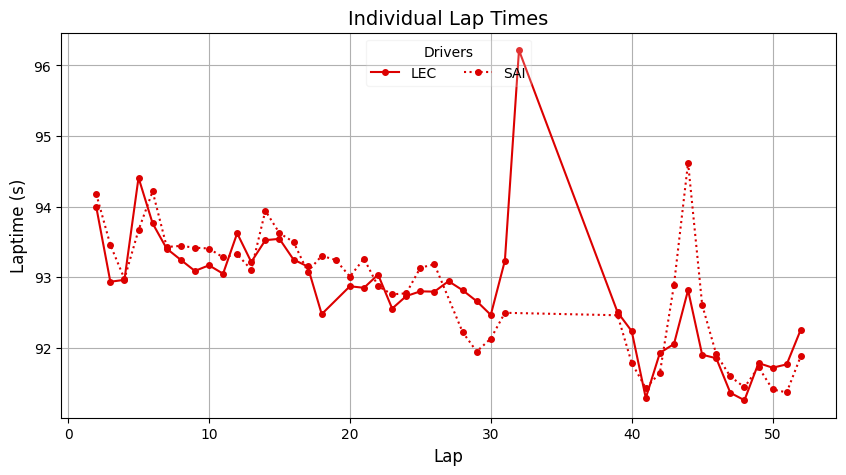
Ferrari experienced yet another challenging weekend, struggling to live up to their potential. Their qualifying performance was decent, as has been the case in most races. They secured fourth and fifth positions on the grid, which is commendable considering the exceptional pace of the McLaren cars. Carlos set a lap time of 1:27.148, while Charles recorded a slightly faster time of 1:27.092 in Q3. Ferrari demonstrated sound strategy by timing their final runs in Q3 towards the end of the session, a straightforward approach where they have often encountered difficulties.
Unfortunately, the race did not pan out favorably for Ferrari. Both drivers adopted slightly different strategies. Charles was pitted early on lap 20 for the harder compound, but this decision backfired due to the Virtual Safety Car (VSC) and subsequent deployment of the Safety Car on lap 33—a testament to Ferrari's luck. It appeared they were aiming for a one-stop strategy with the earlier pit stop for Leclerc. However, he was brought back in under the safety car to switch to the medium compound, which he utilized for the remainder of the race. Carlos followed a different path, pitting on lap 26 just before the safety car period, which was unfortunate timing beyond their control. He switched to the harder compound and stuck with it for the rest of the race, without standing out in terms of performance.
In the end, Charles finished in 9th place, with Carlos in 10th. It seems Charles' pit stop onto the mediums may have contributed to his finishing ahead of Carlos. The medium tires appeared to be better suited for the car's performance over the weekend. As mentioned earlier, there were striking similarities between Mercedes and Ferrari throughout the race, recording almost identical overall race performances. However, Mercedes achieved much higher positions overall, further solidifying Ferrari's disappointing weekend.
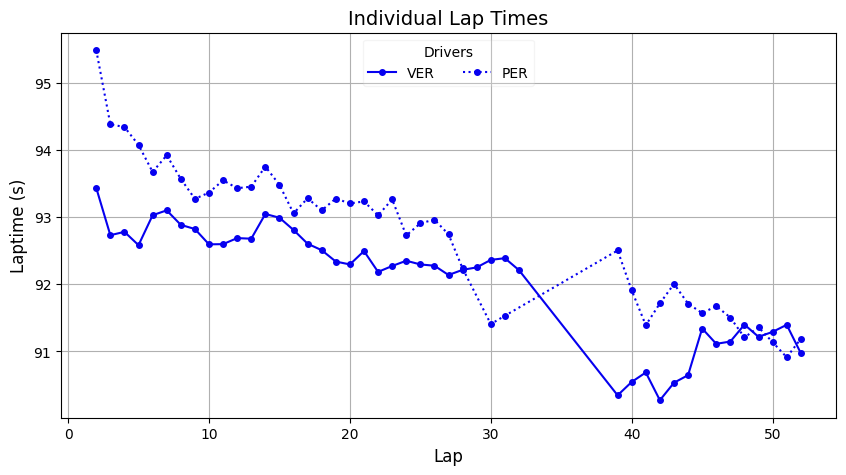
Let's delve into the dominant force that is Red Bull. However, there were a few hiccups within the team over the weekend, particularly for Sergio Perez. It has been a challenging couple of races for him as he has failed to advance beyond Q1 in the last five races. Normally, Perez compensates for this by battling his way through the field to secure points. Of course, having a teammate like Max Verstappen, who can win races even if Perez finishes last, helps Red Bull in the Constructors' Championship. Nevertheless, it must be tough to occupy the second seat at Red Bull, constantly being compared to one of the greatest drivers of all time. Additionally, the car seems to be tailored to suit Verstappen's driving style, making it even more challenging for Perez. Hopefully, he can turn his fortunes around.
Meanwhile, Red Bull's sister team, AlphaTauri, has replaced Yuki Tsunoda with the returning Daniel Ricciardo. This move suggests that AlphaTauri is assessing how Tsunoda matches up against a proven and talented driver, potentially considering a replacement for Perez. However, it is highly unlikely that such a scenario will unfold. Perez and Verstappen complement each other well, and I believe their partnership is beneficial for Red Bull.
As expected, Verstappen would secure pole position and briefly lose the lead into the first corner. However, he would quickly regain the top spot within a few laps and proceed to dominate the race, securing another victory. On the other hand, Perez, starting from 15th place, would finish in 6th position. Once again, the chart above illustrates Verstappen's consistent performance, while Perez falls slightly behind. Perez does show improvement when he enters his second stint and switches to the soft tires, setting solid lap times.
If Perez can rediscover the form he showcased at the beginning of the season, Red Bull will be able to widen the gap further, firmly establishing their dominance in the championship.
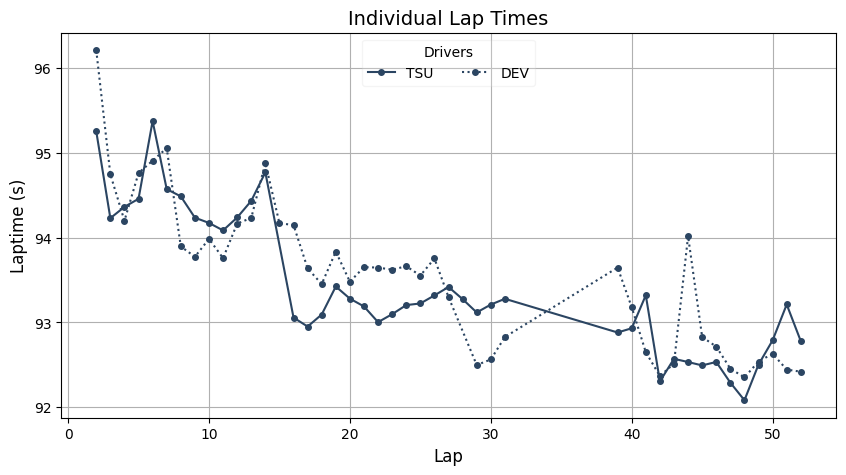
AlphaTauri had another challenging weekend, with their cars consistently finishing towards the back of the pack. It has been a tough season overall for the team. Despite high expectations at the start of the year, particularly with the addition of Nyck de Vries, a former Formula E champion and Formula 2 winner, AlphaTauri has struggled to find success. There was considerable hype surrounding de Vries, with reports of his deep involvement in team activities and the belief that he could bring something special. However, as the season progressed, de Vries was let go and replaced by Daniel Ricciardo. It remains to be seen how Ricciardo's arrival will impact the team, and we will cover that in our next email.
Returning to the past weekend, Yuki Tsunoda qualified in 16th place, while Nyck de Vries secured the 18th spot. Looking at the team's qualifying battles, Yuki holds an 8-2 advantage over Nyck. In the race, they technically finished last, excluding the three cars that retired. Nyck crossed the line in 17th, with Yuki in 16th position. Examining their lap times, it is evident that although they are off the pace, Yuki tends to deliver more consistent laps, while Nyck's performance appears more scattered. This discrepancy could be attributed to the challenging nature of the car itself. It is worth noting that last year, when Nyck stepped in and achieved 9th place in the Williams (as shown in the scatter plot below), it was not a significantly better car. Nerves and putting forth one's best effort may have played a role then. However, one would expect similar performances throughout this season. Only time will reveal if parting ways with Nyck was the best decision for the team.